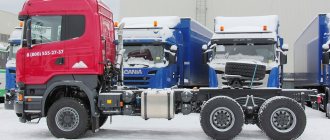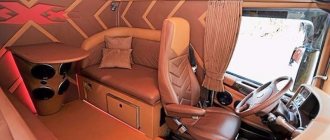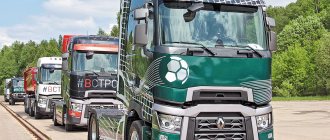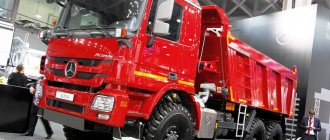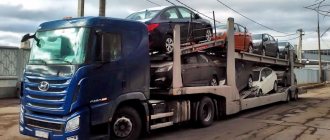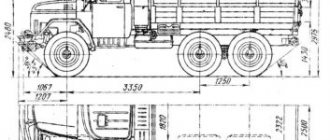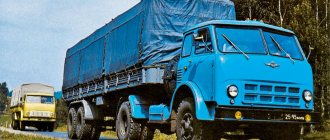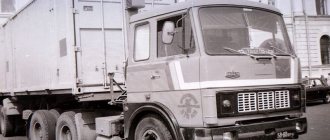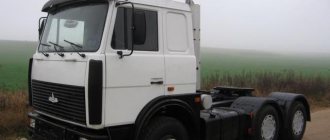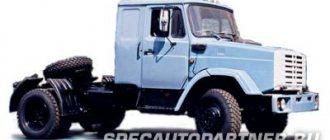MAN invited us to test the TGS 33.480 timber carrier, and at the same time to participate in the process of delivering cargo to consumers. To plunge into this process, we went to the forests of the Vologda region
At first glance, the name of the timber truck seems complicated. But it is simply deciphered: TGS is the name of the model, the number “33” means the total weight of the tractor in tons, and the number “480” indicates the maximum power of its 6-cylinder turbodiesel.
The engine is equipped with AdBlue injection to meet increasingly stringent environmental regulations. Thanks to a powerful and reliable electric torch device, its successful start-up is ensured in temperatures down to -30 degrees. And for even lower temperatures, you can order a pre-heater and an insulated battery box with a built-in heat exchanger.
The gearbox on our test unit is a 16-speed manual, manufactured by ZF. The transmission is designed for a maximum torque of 2500 Nm. Due to the fact that the maximum engine torque is 2300 Nm, the gearbox has a high safety margin. Thanks to the pneumatic booster, gear shifts are much easier than with conventional “mechanics”. It is possible to equip the tractor with a ZF 12-speed robotic transmission, but it is rarely ordered in Russia: the “mechanics” have more gears, which is very important for heavy timber trucks.
There is something unusual and, perhaps, even fascinating about timber trucks.
And if the timber carrier is also an SUV with the most advanced equipment, then this combination is doubly interesting. The MAN TGS 33.480 log truck with rubber is just like that.
We met him at the III Championship “Lumberjack of the 21st Century” near the village of Kononovskaya, Ustyansky district, Arkhangelsk region. The essence of the Championship is a competition in skillful control of forestry machines. Representative event - 42 teams, 1,500 participants and guests of the championship from Russia, Belgium, Germany, Canada, Norway, USA, Finland with a substantial prize fund.
01.
And the most beautiful places! This is what the championship site looks like. At least put a picture on your desktop screensaver. Click on the image and you will get wallpaper 1920x1080
02.
During the championship there is an exhibition of equipment.
Among the participants were many famous brands, but in the automotive part of the exposition, MAN
.
03.
The off-road log truck with a bright yellow cab,
the MAN TGS 33.480
, was certainly the star of the show. We are studying a machine designed to work using Scandinavian technology.
Industry experts know very well what “Scandinavian technology” is. But, since we are read not only by professional lumberjacks, we will reveal its essence with a detailed Remark
.
Remark by M-Park
The main tenets of Scandinavian technology are the maximum reduction of manual labor, primary processing of wood right at the cutting site and its rapid transportation. All this is achieved through the use of a complex of three types of machines - harvesters, forwarders and log carriers.
04.
Meet the harvester. He’s also an “iron woodcutter”, he’s also a forestry harvester, he’s also a manipulator-type felling-delimbing-crosscutting machine (mommies, some kind of phrase... Jack the Ripper would definitely have liked the term).
In essence, a harvester is a “cunning” high-traffic tractor with a special manipulator for mechanized felling and cutting of trees.
05.
There are various layouts of harvester chassis - two-, three-, four-axle, with an articulated frame.
06.
Manipulators are mounted both at a distance from the cabin and next to it. The most “advanced” models can have a lifting cabin, with its own leveling and leveling system.
But, no matter what the chassis of the forest harvester, the main working body of all “iron woodcutters” is the same - the harvester head - a technologically complex and expensive product, the operation of which requires the highest qualifications.
07.
The harvester head is a gripping mechanism, a cutting device for felling and bucking wood, a limbing mechanism and a length measuring mechanism, arranged in a single unit.
08.
The harvester wields the log like a kung fu master with a pole - rotates it in all directions, drives it back and forth, cutting off branches, and, like a chef, cuts carrots into pieces. Everything happens so quickly that it seems that the eye does not have time to notice all the movements of the cutting elements of the harvester head. Honor and praise to the art of the operator! Yes, this is not even a job, but an art.
One harvester replaces several teams of tough men with chainsaws, but without a forwarder a harvester is like Don Quixote without Sancho Panza.
09.
The forwarder's job is to collect the logs that the harvester has cut and scattered and take them to the loading area for the log truck. Instead of a harvester head, forwarder manipulators are equipped with a clamshell grab for loading logs. The cargo compartment of the forwarder is formed by bunks and a lattice front wall.
10.
Forwarders crawl where no truck can get. That's what they were created for. Having collected the “harvest” that was “cut” by a fellow harvester, the forwarder removes the assortments from the plot. The distance from the plot to the loading area is usually relatively short.
11.
Near relatively good roads, forwarders form neatly stacked stacks of logs, for which a car/road train - a log carrier - arrives. An assortment, by the way, is a processed log of a fixed length.
12.
The stacks formed by the forwarder are reloaded by the log carrier. The operators load so deftly, accurately and quickly that it seems that it will take me longer to collect a scattered box of pencils than it takes an experienced operator to load a log truck.
13.
Don’t let the MAZ cabin of the shown log truck confuse you.
The soul and, especially, the “heart” of this truck is MAN
.
This is MAZ-MAN 632559
- the first log carrier of
the MAZ-MAN
.
Its engine is MAN
. When the time comes, we’ll tell you about this car separately.
It was the “operation” of the log truck manipulator that was the most, so to speak, spectacular exercise at the competition of the “Lumberjack of the 21st Century” championship.
14.
For this discipline
, MAN
provided two special timber transport vehicles -
MAN TGS 33.480 6x6 BB-WW
with
Palfinger Epsilon M100L
and
Kesla 2009sT
.
15.
Here you need to assemble a log house from 12 six-meter logs with a diameter of 160-200 mm in 10 minutes and disassemble it, placing all the logs in the back of a log truck. In a word, controlling the log truck manipulator is not only an art, but now also a sporting discipline.
16.
But let's get back to work. Once loaded, an ordinary log truck delivers primary processed logs to the main base or directly to the customer along good roads, and in Europe, simply along an asphalt highway. These cars don’t need all-wheel drive...
But we are in Russia
So we smoothly approached the “Russian features of Scandinavian technology” included in the title.
Russian forest expanses are huge. The loading area of a log truck could easily be not next to a good road, but 20 kilometers away from it.
17.
Then the driver of the log truck will have this or an even more extreme view from the cab.
18.
That’s why off-road log trucks are popular in Russia.
The leader of the market segment - “our everything truck” - is KAMAZ
, for which dozens of “bodybuilders” make log superstructures.
19.
And so
MAN
offered its off-road log truck. The rainy summer of this year only emphasized the relevance of such equipment, and now a new “face” has appeared on difficult logging trails.
20.
The base truck index is
MAN TGS 33.480 6×6 BB-WW
.
Engine - 480-horsepower MAN D2676LF20
, gearbox - ZF. In essence, it is a serial chassis from the standard MAN program (and this is an advantage for the speed of order fulfillment for such a vehicle) with an unusual configuration.
Off-road MANs are an interesting topic. Literally a small, brief Remarque
about them.
M-Park's remark
21.
Off-road
MAN
6x6s are popular with us, mainly among oil workers.
Here, for example, is the “severe Surgut long-distance truck” of the TGA
in the corporate coloring of Surgutneftegaz.
22.
This is also an “oil tanker”, a cementing unit for strengthening foundations during the development of wells.
, the SJS PCT-611A
pumping unit was manufactured in China, mounted in Russia, and the base chassis is an all-wheel drive
MAN TGS 33.430
.
23.
MAN
6x6
SUVs are also MAN
is almost the most popular rally vehicle brand in the world.
And also - firefighting and military spheres - all this is the domain of MAN
6×6.
But let's return to our handsome log truck.
24.
The timber truck inherited the diode “chandelier” on the roof from the rally technical vehicles.
25.
The most interesting thing about this option is the tires and accessories for them.
26.
Next to each wheel there is a special case where the remote air pumping hose is stored.
27.
You can connect your own pump to each wheel. If necessary, you can reduce the tire pressure to overcome particularly difficult terrain, and then quickly restore it.
28.
The tire pressure regulation system is a product of the German company
ti.systems GmbH
, one of the world leaders in this field.
The system is called
STIS
,
which stands for
Semi
- automatic
Tire
Inflation
System .
29.
STIS
works as follows.
The distribution block is connected to the chassis pneumatic system, and from it pneumatic distribution is already carried out to each tire. STIS
allows you to adjust the pressure in the range from 0 to 10 bar. 8 preset modes can be configured. The regulation process occurs very quickly, but the car must be stopped. The system is not designed to operate while moving.
30.
A very interesting tire model was used.
This is Michelin 14.00/R20 XML
.
31.
The main feature of the tires is their particularly developed lateral lugs.
Such tires in combination with the STIS
guarantee particularly high cross-country ability.
32.
Now let's look at the features of the special superstructure.
33.
Kesla 2009sT
crane installation was used .
34.
The CMU is equipped with a rather interesting and infrequently encountered option - an additional hydraulic fluid cooling system, which will definitely prevent the oil from overheating.
35.
And there is a lot of hydraulic oil here. The volume of the hydraulic tank (silver, left) is about a third of the fuel tank. An additional tool box and a urea tank are located between the hydraulic tank and the fuel tank.
The supplier of the log-carrying superstructure is the Finnish company Alucar
, which professionals call “the best among equals.” The name of the company itself hints at the material with which it works - aluminum.
36.
It is from winged metal that
Alucar
makes the subframe assembly, the front shield and logging bunks - the main elements of the logging superstructure. Aluminum is three times lighter than steel. Thanks to the use of this material, the timber storage unit weighs on average about half a ton. Therefore, the payload increases.
37.
Alucar
equipment that is installed on this truck, and the “bodybuilder” was from St. Petersburg, as evidenced by the corresponding logo.
38.
As a result, this log carrier combines the most advanced German (chassis), French (tires) and Finnish (superstructure) technologies, assembled by Russian specialists for Russian conditions.
It turned out to be an interesting machine, and for those loggers whose equipment works off-road and whose (and there are such), now there is an interesting option.
King of the road
As I already said, the total weight of the tractor is 33 tons, and with a trailer it can reach 90 tons! However, they didn’t trust me to drive such a road train - I only had a tractor at my disposal, and it was not loaded. However, the impressions were still “through the roof”!
I climb into the cabin, holding on to the comfortable handles, go inside and sink into a luxurious chair. In general, MAN driver's seats can be of three types, and the test unit, of course, has the most sophisticated one installed. There are so many adjustments here! There are a lot of supports and pneumatic supports, even the degree of seat cushioning is adjustable: if you want, swing like in a hammock, or if you want, sit like on a stool. Drivers who operate these tractors say that on rough roads the seat suspension must be stiffened, otherwise you may get an attack of seasickness.
In short, I had a great time behind the wheel! I also praise the ergonomics. Although I rarely deal with trucks, it was not difficult to find the functions I needed. I start the engine, depress the clutch and smoothly move away. The box lever moves easily - it’s not for nothing that it is equipped with a pneumatic amplifier. Despite 16 gears, managing all this “economy” is as easy as shelling pears.
The engine runs almost silently, which is also noted by professional drivers who consider MAN tractors to be among the quietest compared to other brands. The main sound is the whistle of the turbine, soft and very pleasant. Even at high speed, the huge “burdocks” of the side mirrors make noise. These mirrors, by the way, provide excellent visibility, “shooting through” all possible blind spots, of which the car has plenty. So, on the right side there are as many as four mirrors! You can also order a rear view camera.
The thrust of the power unit seems inexhaustible. The steering wheel is light but informative. The suspension does not notice small irregularities at all, but on large bumps a fairly strong vertical swing occurs. In general, to be honest, I did not expect that driving such a large car could be so simple and convenient and even... enjoyable. Many people feel a sense of superiority on the road when driving large SUVs, but driving a timber truck is a completely different story. Here, not only SUVs, but also trucks and buses seem to be some kind of runts! And everyone keeps a respectful distance.
